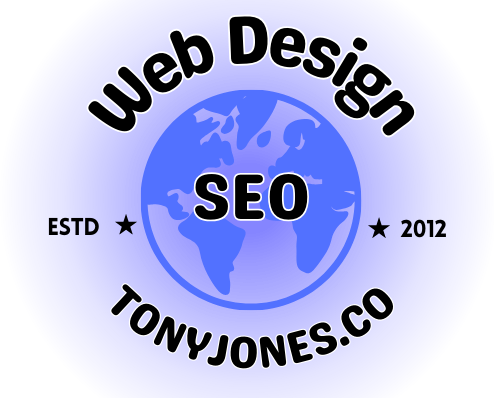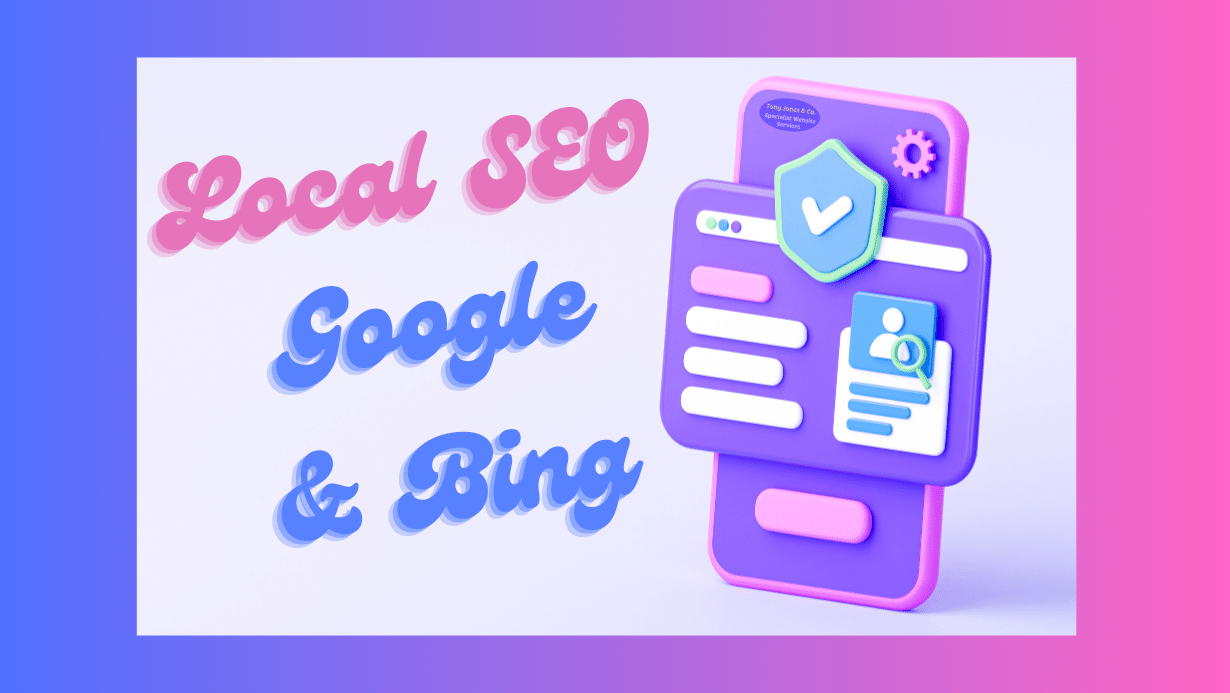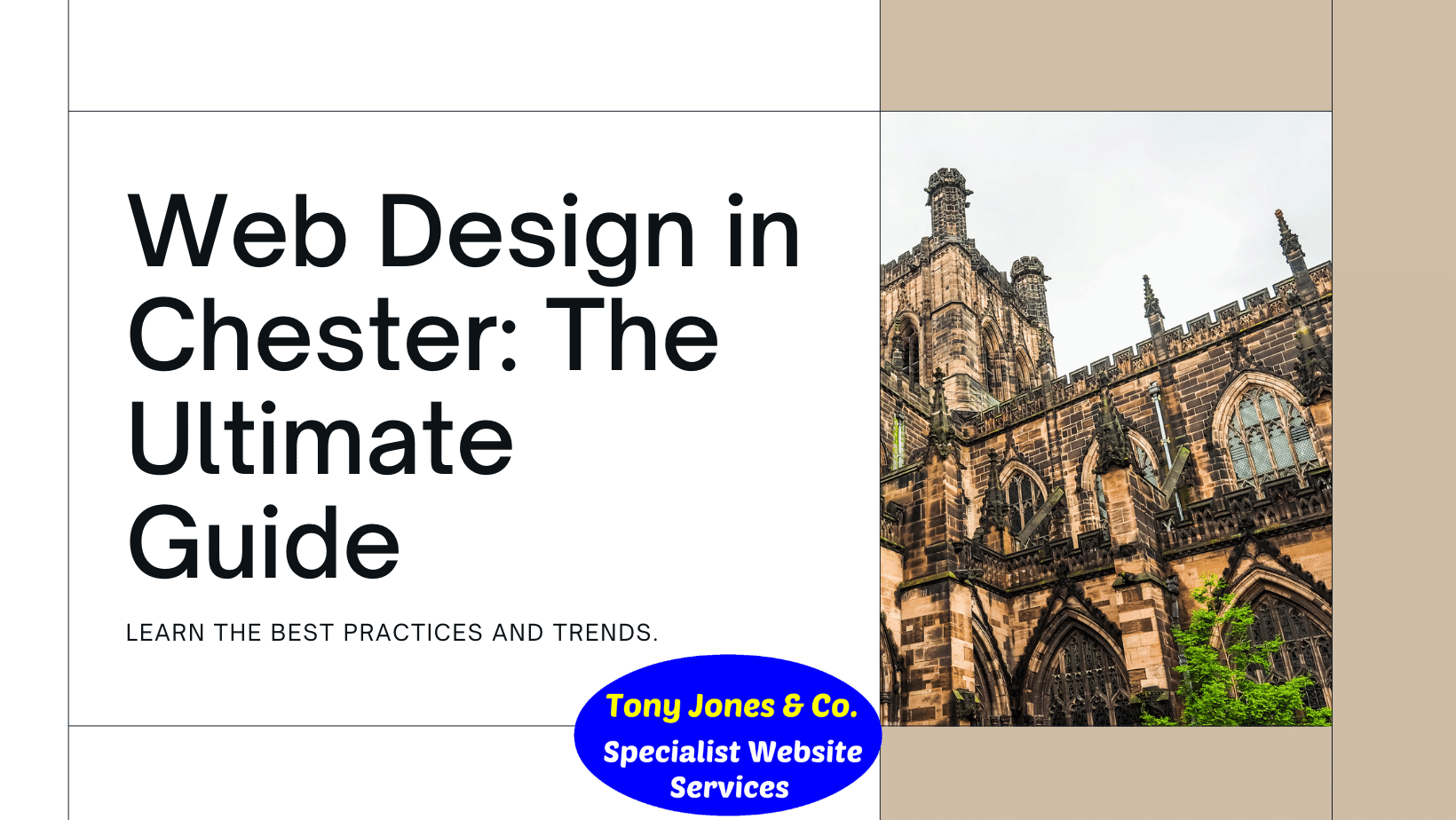Web Designer Wrexham, Professional Website Services - Tony Jones CITP, FBCS.
Mastering the Digital Landscape: Small Business Website Design Tips
The Importance of a Small Business Website

In today's digital age, having a small business website is essential for success. It offers several advantages that can contribute to the growth and prosperity of your business. Let's explore the key reasons why establishing an online presence is crucial for small businesses.
Establishing an Online Presence
Creating a small business website allows you to establish a strong online presence. With the majority of consumers turning to the internet to search for products and services, having a website ensures that your business is discoverable and accessible to potential customers. It serves as a virtual storefront, providing information about your offerings, contact details, and more.
By having an online presence, you can extend your reach beyond the local community and tap into a global audience. This opens up new opportunities for growth and expansion, allowing you to connect with customers from different regions and even other countries.
Reaching a Wider Audience
One of the significant advantages of a small business website is the ability to reach a wider audience. Unlike traditional brick-and-mortar stores, which are limited by geographical boundaries, an online presence enables you to connect with customers from anywhere in the world.
Through effective digital marketing strategies, such as search engine optimization (SEO) and social media marketing, you can increase your visibility and attract a broader customer base. By optimizing your website for relevant keywords, you can improve your search engine rankings and drive organic traffic to your site. To learn more about SEO for small business websites, check out our article on seo for small business websites.
Building Trust and Credibility
A well-designed small business website helps build trust and credibility with potential customers. In today's competitive marketplace, consumers expect businesses to have a professional online presence. A professional website not only showcases your products or services but also reflects the values and professionalism of your brand.
Providing valuable and relevant content on your website demonstrates your expertise in your industry, establishing you as a trusted authority. Additionally, including testimonials and reviews from satisfied customers can further enhance your credibility and instill confidence in potential buyers.
By investing in a well-designed small business website, you can establish an online presence, reach a wider audience, and build trust and credibility with potential customers. Remember to prioritize the website essentials for small businesses and ensure that your website meets the small business website requirements to maximize its effectiveness. To learn more about website essentials and security measures for small businesses, visit our articles on website essentials for small businesses and small business website security measures respectively.
Planning Your Small Business Website
Before diving into the design and development process, it's essential to plan your small business website effectively. This planning phase sets the foundation for a successful online presence. In this section, we will explore three key aspects of planning: defining your goals and target audience, sketching out your website structure, and choosing the right platform.
Defining Your Goals and Target Audience
To create a website that drives results, it's crucial to have a clear understanding of your goals and target audience. Start by asking yourself what you want to achieve with your website. Are you looking to generate leads, sell products, or simply provide information about your business? Defining your goals early on will help shape the design and functionality of your website.
Next, identify your target audience. Consider their demographics, interests, and online behavior. Understanding who your website is catering to will allow you to tailor your design, content, and user experience to their needs. For more information on how to optimize your website for your target audience, check out our article on small business website requirements.
Sketching Out Your Website Structure
Once you have a clear vision of your goals and target audience, it's time to create a website structure. Start by outlining the main pages and sections your website will have. This could include a homepage, about us page, services or product pages, contact page, and any other relevant sections specific to your business.
Consider the flow and organization of information within your website structure. Ensure that visitors can easily navigate between pages and find the information they are looking for. A clear and intuitive website structure improves the overall user experience and encourages visitors to explore further.
Choosing the Right Platform
Selecting the right platform for your small business website is crucial for its success. There are various website builders and content management systems (CMS) available, each with its own set of features and capabilities.
Consider factors such as ease of use, customization options, scalability, and budget when choosing a platform. Popular website builders like WordPress, Wix, and Squarespace offer user-friendly interfaces and a wide range of templates and plugins to customize your website. Alternatively, a custom-built website using a CMS allows for more flexibility and tailored functionality.
Evaluate the pros and cons of each platform and choose the one that aligns with your goals, technical expertise, and budget. For more information on website essentials for small businesses, refer to our article on website essentials for small businesses.
By effectively planning your small business website, you can lay a solid foundation for success. Define your goals and target audience, sketch out a well-structured website, and choose the right platform that meets your business needs. Remember to consider factors like search engine optimization (SEO) and website analytics to ensure your website's visibility and performance. For guidance on optimizing your website for search engines, check out our article on SEO for small business websites.
Essential Design Tips for Small Business Websites
When it comes to designing a small business website, there are several key factors to consider in order to create a positive user experience. In this section, we will explore three essential design tips: simple and intuitive navigation, mobile-friendly design, and consistent branding and visual identity.
Simple and Intuitive Navigation
One of the most important design elements of a small business website is its navigation. Visitors should be able to easily find the information they are looking for without feeling overwhelmed. Keep the navigation menu simple and organized, using clear labels that accurately represent each page or section of your website. Avoid using complex drop-down menus that may confuse users.
Additionally, consider implementing a search bar on your website to allow users to quickly find specific content. This is especially useful if your website has a large amount of information or if you offer a wide range of products or services.
By providing simple and intuitive navigation, you can enhance the user experience and encourage visitors to explore more of your website.
Mobile-Friendly Design
In today's digital landscape, it's essential to ensure that your small business website is mobile-friendly. With the increasing use of smartphones and tablets, a significant portion of website traffic comes from mobile devices. Therefore, it's crucial to optimize your website design for mobile screens.
A mobile-friendly design involves using responsive web design techniques, which allow your website to adapt and display properly on different screen sizes. This ensures that your website looks and functions well on mobile devices, providing a seamless user experience.
Moreover, mobile-friendliness is a crucial factor for search engine optimization (SEO). Search engines, like Google, prioritize mobile-friendly websites in their search results, making it easier for potential customers to find your business. For more information on SEO for small business websites, refer to our article on SEO for small business websites.
Consistent Branding and Visual Identity
Establishing a consistent branding and visual identity is essential for creating a professional and cohesive small business website. Consistency in branding helps to build recognition and trust among your audience.
Ensure that your website design aligns with your brand's visual identity, including logo, color scheme, typography, and imagery. Consistency in these elements across your website helps to reinforce your brand identity and creates a memorable experience for your visitors.
Consider creating a style guide or brand guidelines to maintain consistency throughout your website. This guide can outline the specific usage of your logo, color palette, and fonts, ensuring that they are consistently applied across different pages and sections.
By implementing these essential design tips, you can create a visually appealing and user-friendly small business website that aligns with your brand and engages your target audience. Remember, a well-designed website not only attracts visitors but also encourages them to stay longer and explore your products or services further.
Content Creation for Small Business Websites
When it comes to creating a small business website, compelling content plays a crucial role in attracting and engaging visitors. Well-crafted content can effectively convey your brand message, showcase your products or services, and encourage potential customers to take action. In this section, we will explore three key areas of content creation for small business websites: compelling homepage content, engaging About Us and Services pages, and effective call-to-actions.
Compelling Homepage Content
Your homepage serves as the virtual storefront of your small business website, making a strong first impression on visitors. It's essential to create compelling and attention-grabbing content that immediately communicates what your business is all about and entices visitors to explore further.
To achieve this, consider the following tips:
- Craft a clear and concise headline that encapsulates your unique selling proposition.
- Use engaging and persuasive language to describe the benefits of your products or services.
- Highlight any special offers, promotions, or unique features that set your business apart.
- Incorporate eye-catching visuals such as high-quality images or videos that resonate with your target audience.
- Include social proof such as customer testimonials or case studies to build trust and credibility.
By creating compelling homepage content, you can capture the attention of visitors and encourage them to delve deeper into your website.
Engaging About Us and Services Pages
The About Us and Services pages are key components of your small business website. These pages provide an opportunity to establish a personal connection with your audience and communicate the value you bring to the table.
When crafting content for these pages, keep the following tips in mind:
About Us Page:
- Share the story behind your business, including its origins, mission, and core values.
- Highlight the expertise and experience of your team members.
- Showcase any awards, certifications, or industry recognition your business has received.
- Include a call-to-action that encourages visitors to get in touch or learn more about your services.
Services Page:
- Clearly outline the range of services or products you offer.
- Provide detailed descriptions of each service, including the benefits and features.
- Use compelling visuals to showcase your work or product offerings.
- Include customer testimonials to build trust and demonstrate the quality of your services.
By creating engaging content for your About Us and Services pages, you can build trust, establish credibility, and effectively communicate the value of your small business.
Effective Call-to-Actions
A call-to-action (CTA) is a crucial element of your small business website that prompts visitors to take a specific action, such as making a purchase, subscribing to a newsletter, or scheduling an appointment. Well-designed and strategically placed CTAs can significantly impact conversion rates and drive desired user actions.
Consider the following tips when creating effective CTAs:
- Use action-oriented language that clearly communicates the desired action.
- Make your CTA visually prominent by using contrasting colors and positioning it strategically on the page.
- Create a sense of urgency by incorporating time-limited offers or limited availability.
- Ensure that your CTAs are mobile-friendly and easily clickable on all devices.
- Test and track the performance of your CTAs to make data-driven improvements.
By implementing effective CTAs throughout your small business website, you can guide visitors towards the desired actions and increase conversions.
With compelling homepage content, engaging About Us and Services pages, and effective call-to-actions, you can create a small business website that captivates visitors, encourages them to explore further, and ultimately drives conversions. Remember to continuously evaluate and refine your content to ensure it aligns with your target audience and business goals.
Optimizing Your Small Business Website
To maximize the success of your small business website, it's essential to focus on optimization. This involves implementing strategies to improve search engine optimization (SEO), enhancing the speed and performance of your website, and integrating analytics and tracking tools to gain valuable insights. Let's explore these optimization techniques in more detail.
Search Engine Optimization (SEO) Basics
Search engine optimization plays a vital role in ensuring that your small business website appears prominently in search engine results. By optimizing your website for relevant keywords and improving its overall visibility, you can attract more organic traffic and increase your online presence.
To optimize your website for search engines, consider the following techniques:
- Keyword research: Identify relevant keywords related to your business and incorporate them strategically into your website content. This helps search engines understand the relevance of your website to specific search queries.
- On-page optimization: Optimize your website's meta tags, headings, URLs, and image alt tags with relevant keywords. Ensure that your content is well-structured and easy to navigate, making it more accessible to search engine crawlers and users alike.
- Quality content: Create informative and engaging content that provides value to your target audience. Search engines prioritize websites that offer high-quality, original content. Consider incorporating a blog into your website to regularly publish fresh and relevant content.
- Link building: Build relationships with other reputable websites and aim to earn backlinks from them. Backlinks act as endorsements, signaling to search engines that your website is trustworthy and authoritative.
For more detailed information on SEO techniques for small business websites, check out our article on SEO for small business websites.
Speed and Performance Optimization
In today's fast-paced digital landscape, user experience is paramount. Slow-loading websites can lead to high bounce rates and potential loss of customers. Optimizing the speed and performance of your small business website can greatly enhance the user experience and ultimately improve conversion rates.
Consider the following tips to optimize your website's speed and performance:
- Image optimization: Compress images without compromising their quality to reduce file sizes and decrease loading times.
- Caching: Implement browser caching to store static files on a user's device, allowing faster load times upon subsequent visits.
- Minification: Minify your website's CSS, JavaScript, and HTML files to reduce file sizes and improve loading speed.
- Content delivery network (CDN): Utilize a CDN to distribute your website's content across multiple servers worldwide, reducing latency and improving loading times for users in different geographic locations.
By implementing these speed and performance optimization techniques, you can enhance the overall user experience and keep visitors engaged on your small business website.
Integrating Analytics and Tracking Tools
Integrating analytics and tracking tools into your small business website is crucial for understanding your website's performance, user behavior, and conversion rates. These insights can help you make informed decisions to optimize your website and achieve your business goals.
Consider the following tools to gain valuable analytics and tracking insights:
- Google Analytics: Implement Google Analytics to track website traffic, user behavior, conversion rates, and more. This powerful tool provides valuable data to help you understand your audience and make data-driven decisions.
- Heatmaps: Utilize heatmap tools to visualize user interactions on your website, such as clicks, scrolls, and cursor movements. This data can highlight areas of improvement and guide website optimization efforts.
- Conversion tracking: Set up conversion tracking to monitor specific actions taken by users on your website, such as form submissions, purchases, or newsletter sign-ups. This allows you to measure the effectiveness of your marketing efforts and optimize conversion rates.
By integrating these analytics and tracking tools, you can gain valuable insights into your website's performance and make data-driven decisions to optimize your small business website.
Optimizing your small business website through SEO, improving speed and performance, and integrating analytics and tracking tools are crucial steps to ensure the success of your online presence. By implementing these optimization techniques, you can enhance your website's visibility, user experience, and ultimately drive your small business towards growth and success.
Share on:
Questions or further information; please call Tony 07990 797302
About the author Tony Jones CITP FBCS:
An experienced and qualified Web Designer based in Wrexham, a Chartered IT Professional and a Fellow of the British Computer Society.
Contact us
More news and articles: - Websites, Design, SEO, Artificial Intelligence, anything Digital Technology.











